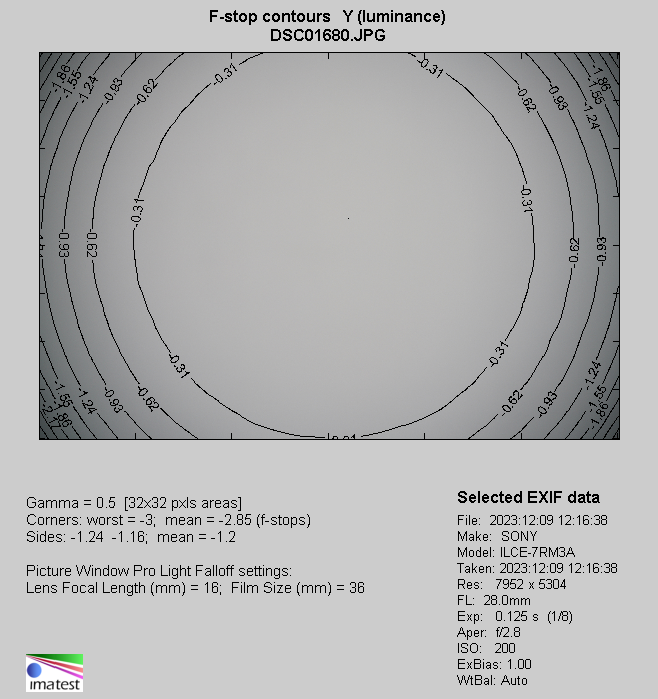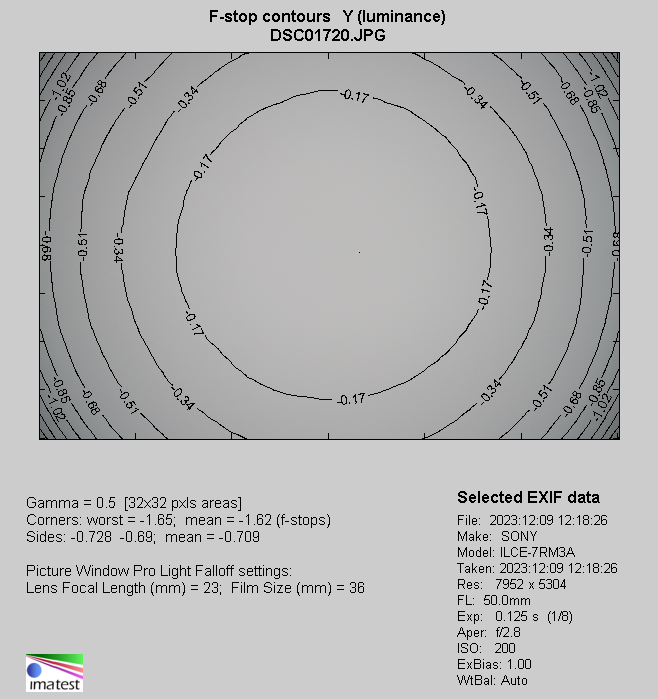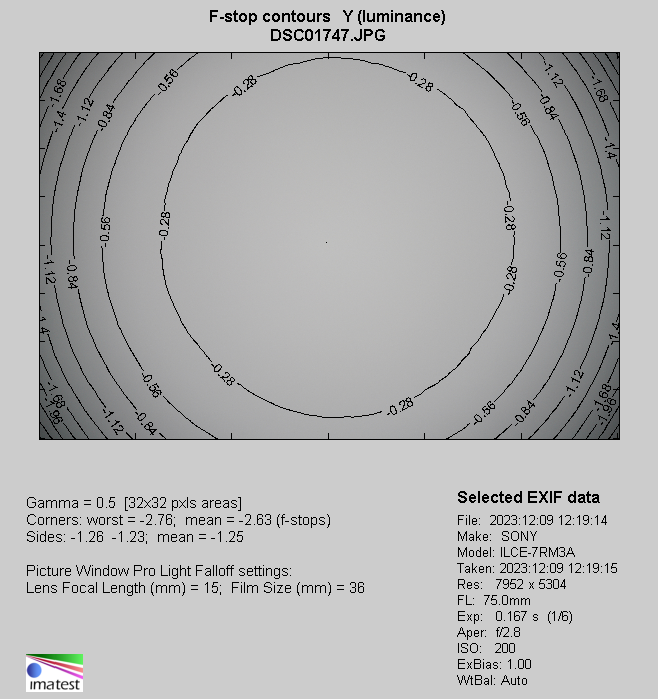Tamron 28-75 mm f/2.8 Di III VXD G2
8. Vignetting
| A7R IIIa, APS-C, 28 mm, f/2.8 | A7R IIIa, APS-C, 28 mm, f/4.0 |

|

|
| A7R IIIa, APS-C, 50 mm, f/2.8 | A7R IIIa, APS-C, 50 mm, f/4.0 |

|

|
| A7R IIIa, APS-C, 75 mm, f/2.8 | A7R IIIa, APS-C, 75 mm, f/4.0 |

|

|
In this case there are no problems at all at any focal length to boot. Applying the widest angle of view available and f/2.8 you have to deal with a loss of just 14% (−0.45 EV) of light in frame corners. The problem disappears practically completely by f/4.0, where it reaches just only 9% (−0.27 EV). By f/5.6 that value remains the same.
Please Support UsIf you enjoy our reviews and articles, and you want us to continue our work please, support our website by donating through PayPal. The funds are going to be used for paying our editorial team, renting servers, and equipping our testing studio; only that way we will be able to continue providing you interesting content for free. |
- - - - - - - - - - - - - - - - - - - - - - - - - - - - - - - - - - - - - - - - - - - - - - - -
Even a slightly better result you see in the middle of the focal range where, by f/2.8 and f/4.0 we got the following results: 13% (−0.39 EV) and 6% (−0.19 EV) respectively.
At the maximum focal length and maximum relative aperture vignetting amounts to 17% (−0.53 EV) and then it drops to an imperceptible level of 6% (−0.17 EV) on stopping down the lens to f/4.0.
Now let's check how the tested lens performs on a full frame detector – appropriate photos can be found below.
| A7R IIIa, FF, 28 mm, f/2.8 | A7R IIIa, FF, 28 mm, f/4.0 |

|

|
| A7R IIIa, FF, 50 mm, f/2.8 | A7R IIIa, FF, 50 mm, f/4.0 |

|

|
| A7R IIIa, FF, 75 mm, f/2.8 | A7R IIIa, FF, 75 mm, f/4.0 |

|

|
At the most difficult combination of wide angle of view and the f/2.8 aperture there are a lot of problems, with vignetting reaching a value as high as 63% (−2.85 EV). Still, it's worth mentioning the fact that this result remains better than the result of the predecessor of the tested lens, which showed even a tad higher level, that of 66%.
At f/4.0 vignetting drops to a value of 44% (−1.70 EV), by f/5.6 it decreases to 30% (−1.05 EV), and by f/8.0 it gets even lower, amounting to 22% (−0.70 EV). Further stopping down doesn't produce any measureable effects.
In the middle of the focal range you can notice a distinct improvement of the performance. By f/2.8 brightness loss in frame corners amounts to 43% (−1.62 EV) and then it decreases to 27% (−0.91 EV) on stopping down the aperture to f/4.0. By f/5.6 and f/8.0 apertures we got the following results: 15% (−0.49 EV) and 14% (−0.45 EV) respectively.
At the 75 mm focal length you can observe the return to weaker results. At the maximum relative aperture vignetting amounts to 60% (−2.63 EV), by f/4.0 it drops to 40% (−1.48 EV), and by f/5.6 it decreases to 25% (−0.84 EV). By f/8.0 and f/11.0 apertures we recorded the following results: 19% (−0.62 EV) and 14% (−0.43 EV) respectively.
| Sony A7R IIIa, 28 mm, f/2.8 |
 |
| Sony A7R IIIa, 50 mm, f/2.8 |
 |
| Sony A7R IIIa, 75 mm, f/2.8 |
 |






